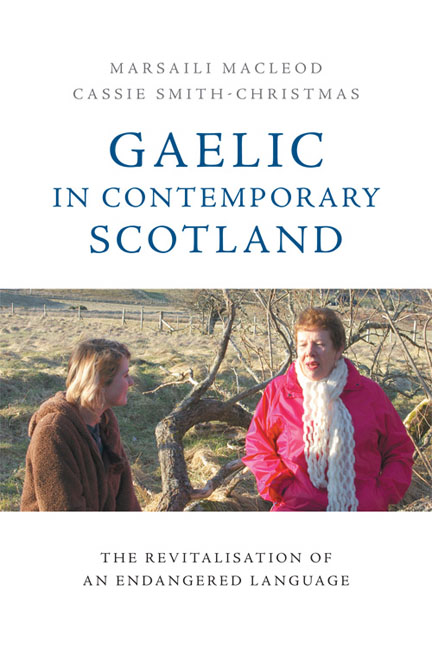Book contents
- Frontmatter
- Contents
- List of Figures
- List of Tables
- Notes on Contributors
- Foreword: Assailed yet Resolute
- Acknowledgements
- List of Abbreviations
- 1 Introduction
- 2 The Language of the Playground: Activists Building Consensus on the Language Policy and Ethos of a New Gaelic Immersion School
- 3 Mismatches between National and Local Gaelic Development: Cròileagan Dùn Èideann and the Promotion of Gaelic-medium Education
- 4 Gaelic amongst Schoolchildren: Ideas on Language Change and Linguistic Choices in Gaelic
- 5 When School is Over and Done With: Linguistic Practices and Sociodemographic Profiles of Gaelic-medium Educated Adults
- 6 New Speakers of Gaelic: A Historical and Policy Perspective
- 7 Learning Gaelic in Adulthood: Second Language Learning in Minority Language Contexts
- 8 Dlùth is Inneach: Charting Language Ideology in the Contemporary Gaelic World
- 9 Gaelic Language Use in Public Domains
- 10 Planning for Growth: The Professionalisation of the Taskforce for Gaelic Revitalisation
- 11 Organisational Language Planning: Gaelic Language Plans in the Public Sector
- 12 The Future of Gaelic Language Revitalisation in Scotland
- Index
4 - Gaelic amongst Schoolchildren: Ideas on Language Change and Linguistic Choices in Gaelic
Published online by Cambridge University Press: 18 December 2019
- Frontmatter
- Contents
- List of Figures
- List of Tables
- Notes on Contributors
- Foreword: Assailed yet Resolute
- Acknowledgements
- List of Abbreviations
- 1 Introduction
- 2 The Language of the Playground: Activists Building Consensus on the Language Policy and Ethos of a New Gaelic Immersion School
- 3 Mismatches between National and Local Gaelic Development: Cròileagan Dùn Èideann and the Promotion of Gaelic-medium Education
- 4 Gaelic amongst Schoolchildren: Ideas on Language Change and Linguistic Choices in Gaelic
- 5 When School is Over and Done With: Linguistic Practices and Sociodemographic Profiles of Gaelic-medium Educated Adults
- 6 New Speakers of Gaelic: A Historical and Policy Perspective
- 7 Learning Gaelic in Adulthood: Second Language Learning in Minority Language Contexts
- 8 Dlùth is Inneach: Charting Language Ideology in the Contemporary Gaelic World
- 9 Gaelic Language Use in Public Domains
- 10 Planning for Growth: The Professionalisation of the Taskforce for Gaelic Revitalisation
- 11 Organisational Language Planning: Gaelic Language Plans in the Public Sector
- 12 The Future of Gaelic Language Revitalisation in Scotland
- Index
Summary
Today's children's Gaelic is different in a number of ways from the Gaelic that their grandparents’ generation would speak (cf. Gillies 1980; MacAulay 1982; NicLeòid 2016). Sometimes Gaelic-medium pupils receive harsh reactions from older, native speakers, such as: ‘Chan eil fhios ‘am dè tha thu ag ràdh an sin! Dè seòrsa Gàidhlig a th’ agad an sin?‘(‘I don't know what you're saying there! What kind of Gaelic is that?’). Comments of that kind usually refer to different aspects of change which native speak-ers recognise in the children's speech in comparison to their own. The most obvious change manifests itself in the choice of vocabulary. Sometimes this means that the younger generation uses Gaelic terms where the older would traditionally use English (for example, for names of the months), but also newly coined terminology which is established in schools and other educational institutions, for specific subjects (math-ematics, science and so on) – a necessary prerequisite for minority language immersion education in order to teach subjects which had never been taught through that particu-lar language before (cf. Slaughter 1997; Baker 2011) − but unknown to speakers who were not educated through the medium of Gaelic (cf. McIntyre 2009; Baker 2011). Further changes concern grammatical structures in the language (cf. NicLeòid 2016).
To an extent, linguistic differences may be expected as a part of normal language change between generations, in any language (cf. Dorian 1981, 1994; Johnstone 2002; Thomason 2007). However, the process of language change is different for minority languages, due to the strong, continuous influence of the majority language(s) (Clyne 1992; Sankoff 2001; Baker 2011). Apart from that, language attitudes of the minority language speakers themselves can influence linguistic domains and speaking patterns as well (Baker 1992; Bradley 2013 [2002]). This means that, in general, minority lan-guages deal with more complex linguistic and meta-linguistic factors in the process of language change (Martin-Jones 1988; Aitchison 2001). These will be discussed later, within the context of the research data.
- Type
- Chapter
- Information
- Gaelic in Contemporary ScotlandThe Revitalisation of an Endangered Language, pp. 45 - 61Publisher: Edinburgh University PressPrint publication year: 2018



